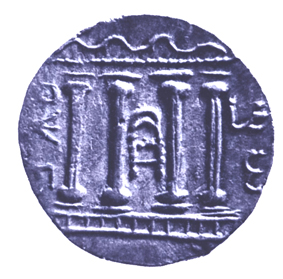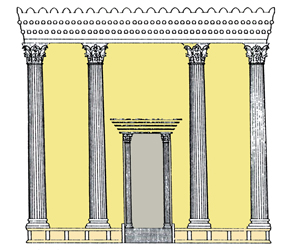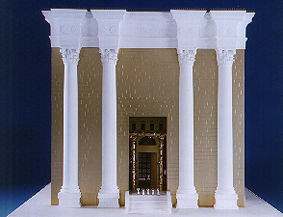A large cache of rare coins has been found by archaeologists in the Judean Hills. “Leaders of the Jewish resistance imprinted and dated coins for each year of the rebellion with, for example, images of the exterior of the Second Temple in Jerusalem and poetry for reclaiming Jerusalem as a means for spreading the rebellion via currency.”
Of special interest is the coin shown in the Jerusalem Post report, which dates from the third year of the Maccabean revolt. The Temple coins show a facade with four columns, a foundation course, a central entrance and a wavey line on top, perhaps representing the entablature. It was clearly an indication that the Jewish rebels against the Roman domination wanted to rebuild the Temple, once their freedom was regained. I once used a similar coin to reconstruct the facade of the Temple for an Israeli scholar and later used the information to design a reconstruction model of the Temple.

A Bar-Kokhba coin of year 3 showing the facade of the Temple

The reconstruction drawing of the Temple facade is based on the coin’s image

A reconstruction model showing the facade of Herod’s Temple

Gideon – it is a matter of proportion. Placing the pilasters at the corners makes the space between the pilasters too large.
Leen, you say Dan Barag says that the coin shows a side view of the table of shewbread.
From one letter of Simon bar Kohkba, it looks as though he had a great interest Sukkot or the festival of booths. He wrote something like:
“Shimeon to Yehudah bar Menashe in Qiryath ‘Arabaya. I have sent to you two donkeys, and you must send with them two men to Yehonathan, son of Be’ayan and to Masabala, in order that they shall pack and send to the camp, towards you, palm branches and citrons. And you, from your place, send others who will bring you myrtles and willows. See that they are tithed and sent them to the camp. The request is made because the army is big. Be well.” This was in preparation for the festival in his war camp.
I think the arch shapes above the table of shewbread could well be palm branches.
Geoff, interesting idea, but would the priests have brought branches inside the Temple itself? They were used to decorate the Altar with branches, but I don’t know if these were brought inside the Temple also.
Gosh I love the Bar Kochba Temple Enigma. We know from the coins that Bar Kochba appointed a man, Elazar to be High Priest/Cohen Gadol.
This begs the question.
1. Did Bar Kochba against all current scholarship hold Jerusalem and the mount? As the Antonia Fortress was destroyed by Titus there was no longer a Fortress of 600 soldiers to keep a determined band of Rebels from storming the site.
2. Why would he need a H.P. for a Temple no longer in existence.
3. Why mint a coin of a building that no longer existed. It could only be a reminder of what once was. But who amongst the remnant there would really remember or care to be reminded of such a painful page in their history. But again, why the H.P.
4. Could it be that the ruins on the Temple Mount went only so far as the flammable Gold and other valuables that the soldiers could loot? They grabbed the Menorah and the Table of Shewbread as shown on the arc of Titus, incidentally commissioned not by Titus but by his brother Domitian in 82 and who also continued to mint Judea Capta coins to honor his brothers triumph.
5. Was Bar Kochba working with an empty Marble Shell, maybe partially roofed and columns with nicks and cracks and soot covered when this coin was struck. An altar of stone was easily to put together and have Elazar make a humble offering of sacrifices as I dont imagine their were much livestock for the taking.
6. Why a picture of the Table of Shewbread as a Menorah, found throughout Israel in Mosaics of the time and sarcophagi not have been the better recognized symbol to be used.?